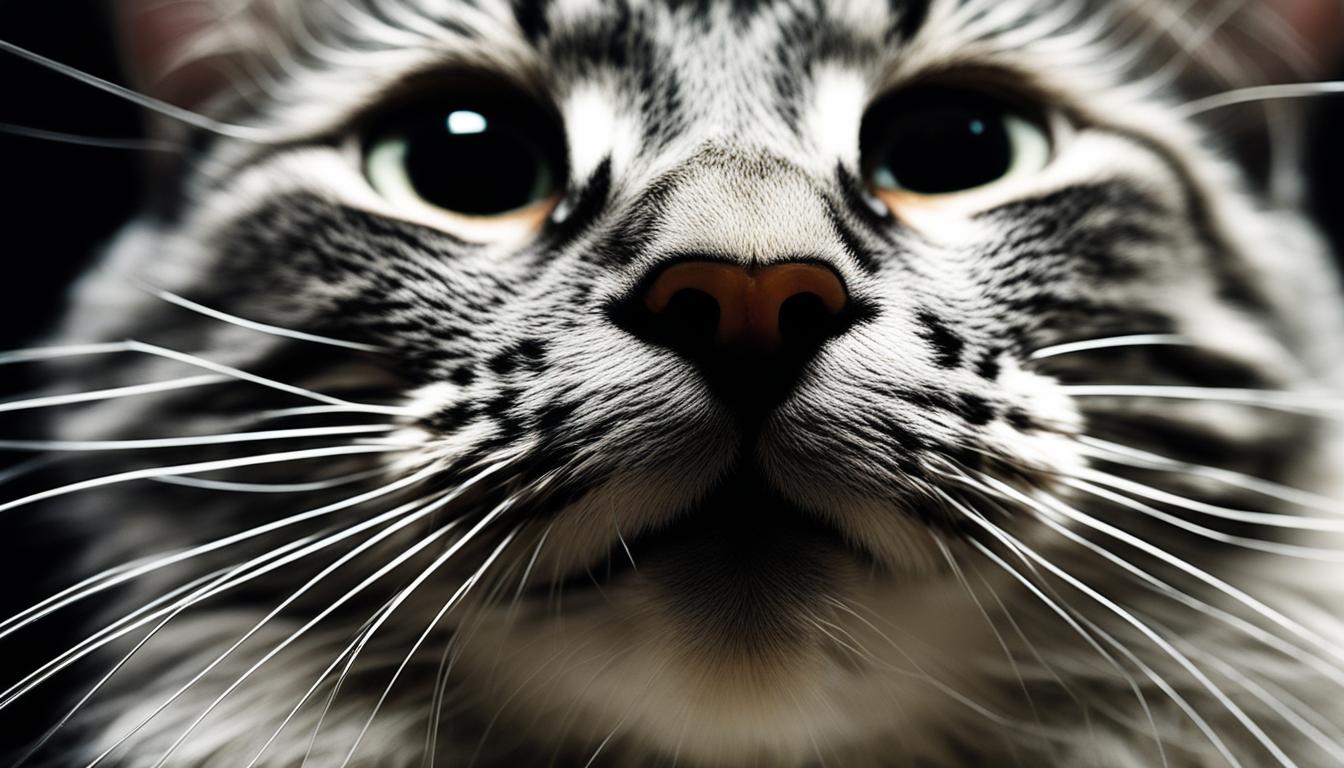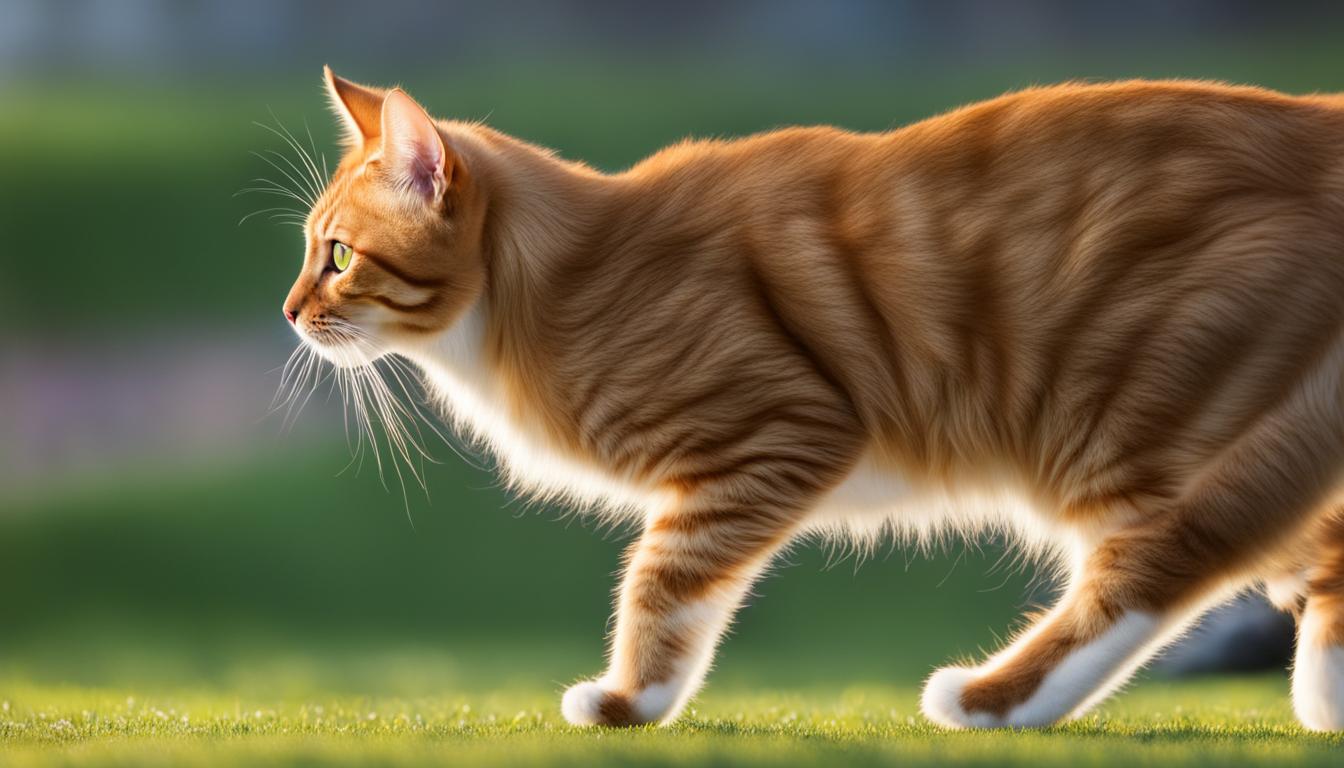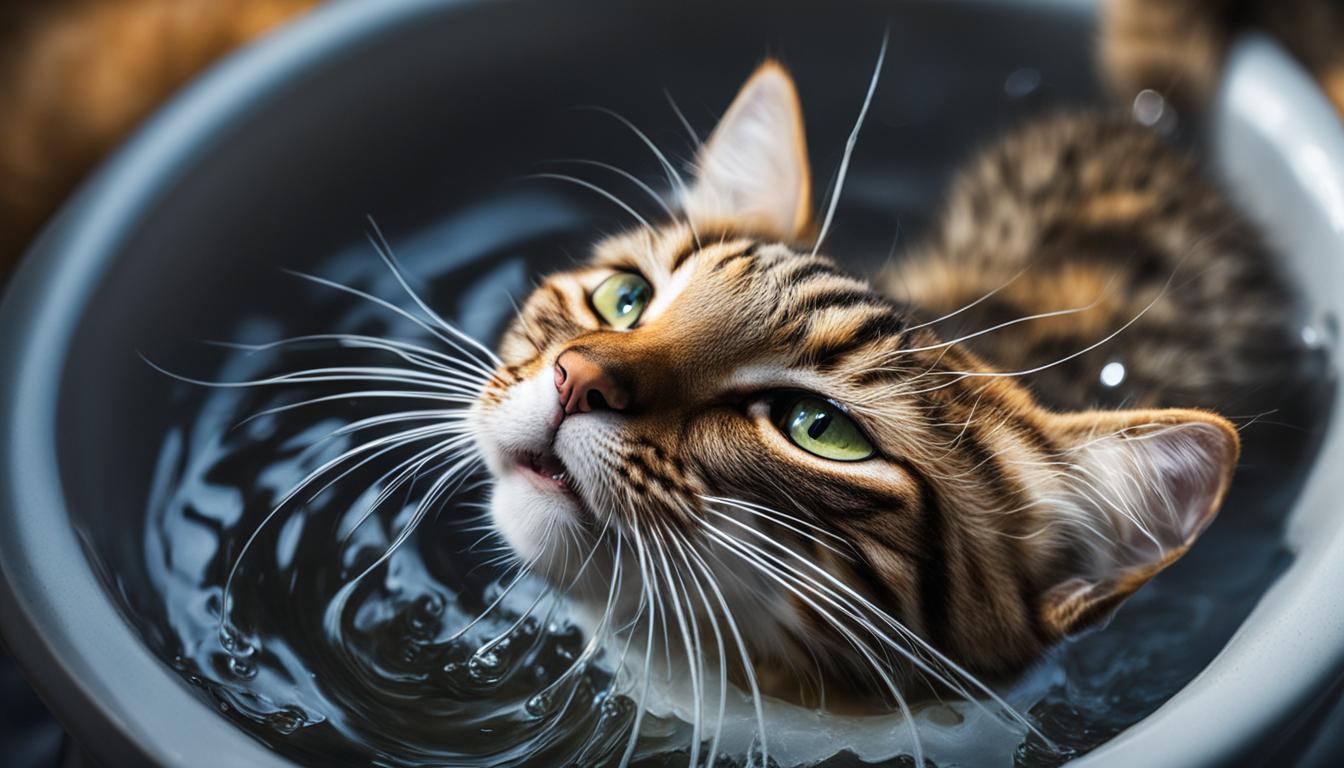Have you ever wondered how cats seem to effortlessly navigate their surroundings or detect the slightest changes in their environment? The answer lies in their remarkable whiskers, also known as vibrissae. These specialized sensory hairs, strategically located on a cat’s face, serve as finely tuned equipment that helps them sense and understand the world around them.
Unlike regular hairs, whiskers are coarser and thicker, with roots that go three times deeper. They are equipped with an abundance of blood vessels and nerves, making them incredibly sensitive. These extraordinary features enable whiskers to transmit vital information to cats, allowing them to navigate, detect objects, and sense physical changes with ease.
Key Takeaways:
- Whiskers, or vibrissae, are specialized sensory hairs that are more sensitive than regular hairs.
- They aid cats in vision, navigation, and detecting objects or movements.
- Whiskers serve as finely tuned sensory equipment, transmitting information about nearby objects’ size, shape, and speed.
- They also act as body balancers, providing cats with information about the position of their body and limbs.
- Whiskers have additional functions, such as communicating emotions and serving as protectors against debris.
What are Whiskers and their Functions?
Whiskers, also known as vibrissae, are not just ordinary hairs on a cat’s face. They play a crucial role in a cat’s daily life, serving as finely tuned sensory equipment that aids in various functions, from navigation to detecting physical changes in the environment.
Compared to regular hairs, whiskers are coarser and thicker. They have roots that go three times deeper and are more sensitive due to the abundance of blood vessels and nerves. This heightened sensitivity allows whiskers to act as radar sensors, detecting vibrations and changes in air currents. As a result, cats can sense approaching dangers and navigate in the dark.
But whiskers have more functions than just sensory perception. They also act as body balancers, providing crucial information to the brain about the position of the body and limbs. This helps cats move with precision and agility, especially when leaping or squeezing through narrow spaces.
Furthermore, whiskers serve as a form of communication for cats. Relaxed whiskers indicate a content cat, while forward-pointing whiskers indicate curiosity. They can also act as protectors, responding to the smallest particles and prompting cats to blink or shake their heads to remove debris.
Table: Whisker Functions
| Function | Description |
|---|---|
| Navigation | Whiskers aid in navigation by detecting vibrations and changes in air currents, helping cats sense their surroundings. |
| Body Balancing | Whiskers provide information about the position of the body and limbs, assisting cats in maintaining balance and agility. |
| Communication | Whisker position can indicate a cat’s emotional state, conveying contentment or curiosity. |
| Protection | Whiskers respond to the presence of particles, prompting cats to take action to remove debris from their face. |
Overall, whiskers are not just cute facial features but functional and essential tools that provide cats with a heightened sense of touch and awareness of their surroundings. It is important to understand and respect the purpose of cat whiskers, ensuring that cats can safely and efficiently navigate their environment.
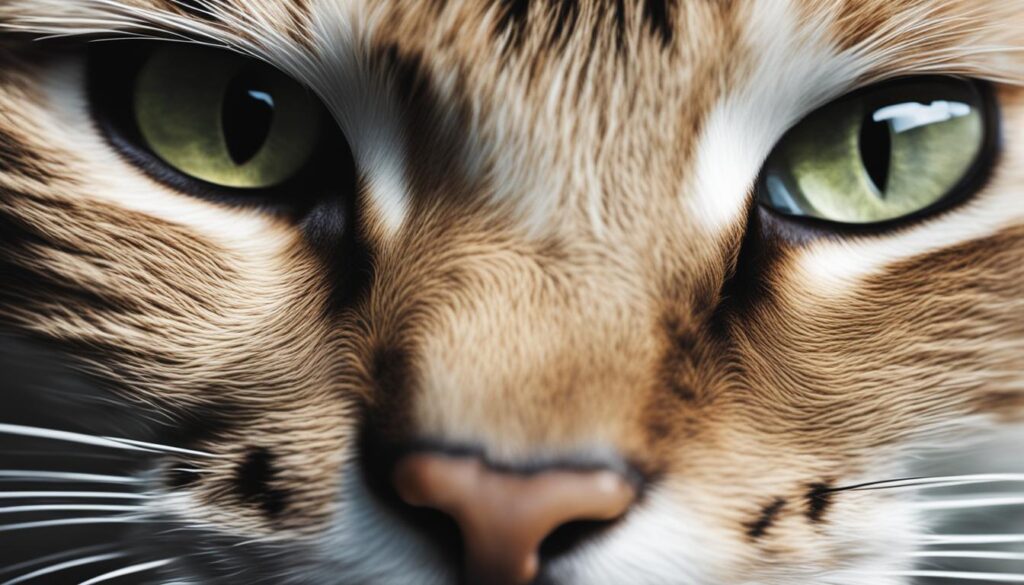
Whiskers as Communication and Protectors
Whiskers in cats serve a dual purpose beyond their role as sensory hairs. They are also essential tools for communication and protection. Cats use the position and movement of their whiskers to convey their emotions. When a cat is relaxed and content, its whiskers are typically in a relaxed position. On the other hand, when a cat is curious or interested in something, its whiskers may be pointed forward. This subtle communication through whisker positions helps cats interact and express themselves.
Furthermore, whiskers act as protectors by detecting potential dangers and removing debris. Even the smallest particles that come into contact with a cat’s whiskers can trigger a protective response. The cat may blink or shake its head in order to clear away the debris. Whiskers also play a crucial role in helping cats navigate narrow spaces. By sensing the width of their bodies with their whiskers, cats can determine whether they can fit through a gap or avoid getting stuck.
Whiskers as Communication and Protectors Table
| Function | Explanation |
|---|---|
| Communication | Whisker positions indicate a cat’s emotions and intentions. |
| Protection | Whiskers detect potential dangers and prompt the cat to remove debris. |
| Navigational Aid | Whiskers help cats determine if they can fit through narrow spaces. |
Overall, the sensitive function of whiskers in cats extends beyond sensory perception. They play a vital role in communication and serve as protectors, ensuring the safety and well-being of our feline friends.
Whisker Distribution and Measuring Abilities
When it comes to the different types of cat whiskers, cats have a symmetrical distribution of these specialized sensory hairs. They typically have 12 whiskers on each side of their muzzle, strategically positioned to provide optimal sensory input. These whiskers, also known as vibrissae, act as built-in measuring tapes for cats.
As whiskers are thicker and coarser than regular hair, they provide cats with valuable information about their surroundings. Cats can rely on their whiskers to gauge the tightness of spaces and the width of their bodies, helping them assess if they can fit through small openings or navigate narrow pathways. Like measuring tapes, the whiskers extend outwards to detect any resistance, indicating to the cat whether there is enough space to proceed.
Moreover, whiskers are not just simple measuring tools. They also excel at detecting vibrations in the air, which aids cats in measuring distances and sensing prey. The sensitivity of whiskers allows cats to accurately assess the proximity of objects or potential targets. Whether they are stalking their prey or assessing their surroundings, cats rely on their whiskers to provide invaluable information.
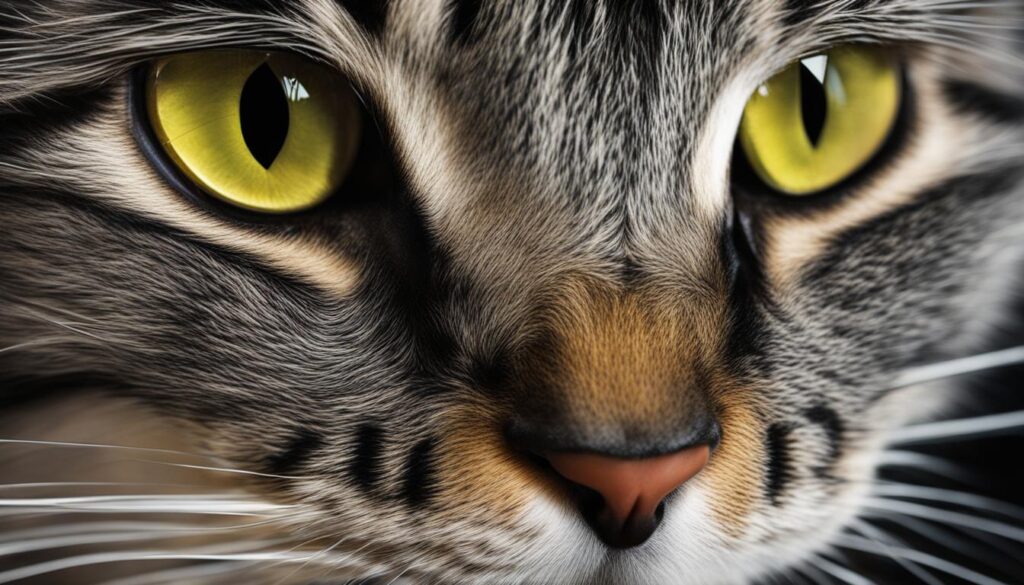
In summary, whiskers serve as both measuring tapes and sensitive detectors for cats. With their symmetrical distribution and exceptional sensitivity, these specialized sensory hairs enable cats to navigate their environment with precision and confidence.
Whiskers and Close-Up Vision
When it comes to close-up vision, cats rely on their whiskers to navigate and gather information about their surroundings. While cats have excellent vision in low light conditions, their ability to focus on objects up close is not as sharp. That’s where their whiskers come in. These specialized sensory hairs act as a guide, allowing cats to explore objects and surfaces that are too close for their eyes to focus on.
The whiskers provide cats with additional information about the size, location, and texture of objects. By touching their whiskers against surfaces, cats can determine if an object is solid or hollow, smooth or rough. This tactile feedback helps them navigate their environment and avoid potential obstacles.
Whiskers also play a crucial role in hunting. When stalking prey, a cat can use its whiskers to measure the distance between itself and the target. By gauging the distance with its whiskers, a cat can make precise and calculated movements to ensure a successful hunt.
| Whiskers and Close-Up Vision | Function |
|---|---|
| Enhance tactile perception | Cats can gather information about the size, location, and texture of objects. |
| Aid in navigation | Whiskers help cats navigate their environment by providing feedback on potential obstacles. |
| Assist in hunting | Whiskers allow cats to measure the distance between themselves and their prey, aiding in precise movements. |
So, the next time you see a cat brushing its whiskers against an object, remember that it’s not just a cute behavior. Those whiskers are helping the cat gather important information and navigate its surroundings.
Whiskers in Other Animals
Whiskers are not just exclusive to cats; they can be found in many other animals across the animal kingdom. These sensory hairs serve similar functions of sensory perception and aiding in navigation in a wide range of species.
One example of whiskers in other animals is horses. Similar to cats, horses have long, coarse facial whiskers that help them navigate their surroundings and detect potential dangers. These whiskers provide valuable information about the proximity of obstacles and help horses avoid accidents.
Additionally, mice also possess whiskers that play a crucial role in their daily lives. Mice use their whiskers to explore their environment, particularly when moving through narrow spaces. These sensitive sensory hairs help mice detect potential threats and find their way through complex maze-like structures.
Whiskers are a common feature across the animal kingdom, playing an important role in how different species perceive their environments.
Furthermore, whisker-like structures can be found in various aquatic animals, such as fish. These structures, known as barbels, are specialized sensory organs located around the mouth. Barbels help fish detect food, sense changes in water currents, and navigate their underwater habitats.
Whiskers, or whisker-like structures, can even be found in insects. Insects have appendages called antennae, which serve as their sensory organs. Antennae help insects sense their environment, detect pheromones, and navigate their surroundings.
Whiskers in Other Animals
Whiskers are not exclusive to cats; they are a fascinating feature that can be observed in various animals, including horses, mice, fish, and insects. These specialized sensory hairs play a vital role in how different species perceive and interact with their environments. Whether in land or water, whiskers provide valuable information that aids in navigation, communication, and survival.

Conclusion
After exploring the fascinating world of cat whiskers, it is evident that these specialized sensory hairs are truly remarkable. They have evolved over time to become highly sensitive and play a crucial role in a cat’s daily life.
Whiskers assist cats in hunting by providing valuable information about the size, shape, and speed of nearby objects. This enables them to make accurate judgments and pounce on their prey with precision. The growth cycle of cat whiskers allows for continuous renewal, ensuring that these essential tools are always in top condition.
Not only do whiskers aid in hunting, but they also play a vital role in navigation. By detecting vibrations and changes in air currents, whiskers allow cats to sense approaching dangers and navigate in dark or unfamiliar environments. They act as built-in measuring tapes, helping cats determine if they can fit through narrow spaces or avoid getting stuck.
As we delve into the evolution of cat whiskers, we begin to appreciate their significance. Whiskers are not just cute facial features, but functional tools that provide cats with a heightened sense of touch and awareness of their surroundings. They are a testament to the incredible adaptability and ingenuity of feline evolution.
FAQ
What are whiskers?
Whiskers, or vibrissae, are specialized sensory hairs that are more sensitive than regular hairs.
What are the functions of whiskers in cats?
Whiskers serve as finely tuned sensory equipment, aiding a cat in vision, navigation, and detecting objects or movements.
How do whiskers help cats navigate their surroundings?
Whiskers provide additional information for cats when objects are too close for their eyes to focus on. They act as a guide, allowing cats to move around with precision.
Do other animals have whiskers?
Yes, many other mammals, such as horses and mice, also have whiskers. Whisker-like structures can be found in various animals across the animal kingdom.
How many whiskers do cats have?
Cats have 12 whiskers on each side of their muzzle, making a total of 24 whiskers.

